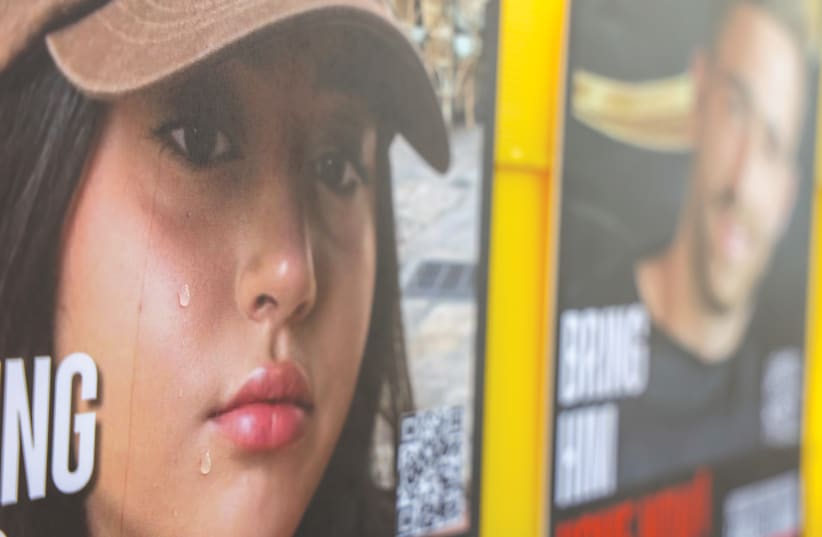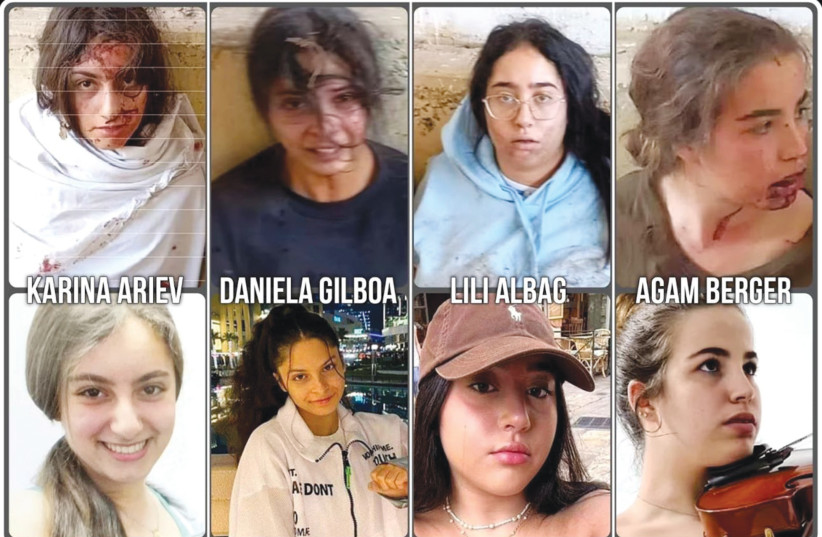There are no limits to evil. As if the mega-atrocity committed by Hamas and Palestinian Islamic Jihad (PIJ) during the invasion of Israel on October 7 was not enough, there is an ongoing use of psychological warfare – a very dirty war, indeed.
The pain of the families of the more than 130 hostages still being held by the terrorists in Gaza is unfathomable. Some of the hostages are known to be dead, their bodies being held as bargaining chips. The fate of the others – around 90 – is unknown, and unimaginable. To describe it as hell for the hostages and for their families is to let Hamas off lightly.
And it’s deliberate. Since that dreadful Saturday, when the well-armed invading terrorists rampaged through southern communities, murdering more than 1,200, raping, mutilating, beheading, and burning, Hamas has used Israel’s fears for the fate of the hostages as a playing card – releasing videos of the abductees to increase the horrors and fears.
Some of those filmed returned home in the hostage release negotiated in November; others were killed during the terrorist equivalent of snuff movies. What the others are experiencing could be a fate worse than death.
Most decent human beings would want to know how they can make the situation better – how they can relieve the suffering. Not so the Iranian regime. Last week, the family of 19-year-old hostage Liri Albag was subjected to an act of particular cruelty. On Friday, a wreath was delivered to the home of the abducted young soldier with a message stating: “May her memory be a blessing, we all know that the country is more important.”
There were two sinister implications: that Liri was no longer alive, and that her death was the result of the lack of will on the part of the Israeli government to pay the price Hamas is demanding for the release of the hostages.
The immediate response was predictable. Apart from the anguish, there was a political backlash. On Sunday, however, the Shin Bet (Israel’s Security Agency) announced that there was a high probability that the wreath had been sent by Iranian agents. The aim was not only to cause extra pain to the Albag family but also to foster the divisions in Israeli society that had been so evident on the eve of the October 7 attack and subsequent war.
Compounding the cynical abuse, the investigation revealed that the flowers had been ordered online in the name of a fallen IDF officer. Iran and its terrorist proxies know how to exploit Israel’s sensitivities.
Liri’s father managed to joke that Liri prefers white flowers to those in the funeral wreath. But nobody was laughing. It was, however, a reminder that the people whose faces appear on the “Kidnapped” posters are real, with likes, and dreams, and loved ones.
The mother of another young soldier kidnapped from her base is also making a plea in conventional and social media for her daughter to be seen as the peace-loving, gentle young woman the family raised.
For most people, the image they have of Naama Levy is of her being dragged by her hair into a truck that would take her to captivity in Gaza, her blood-stained pants a chilling testimony to what she had already undergone. Her fate remains unknown.
The battle over the public image of Shani Louk is even more poignant. A harrowing photo shows the semi-naked, abused body of the 22-year-old being paraded by armed terrorists through the streets of Gaza on the back of a pick-up truck.
The picture, taken by freelance photographer Ali Mahmud and published by the Associated Press, was one of those recently awarded Team Picture Story of the Year by the Missouri School of Journalism’s Reynolds Journalism Institute.
It depicts the death of the young, fun-loving, tattoo artist, kidnapped from the Supernova rave party, but it tells nothing of her life and the way her family wants her to be remembered.
It is telling in other ways. As the NGO HonestReporting noted in November, the Palestinian freelance photographers like Mahmud, who arrived with the terrorists early on October 7 and documented their atrocities, were unlikely to be innocent bystanders who happened to be in the right place at the right time, equipped with the right photographic equipment.
This was photographic shooting to kill in the psychological war, and the fact that the photographer is being granted an award for it is a sign of our twisted times.
A petition demanding that Nikon, a major sponsor of the prize, denounce the award to AP has been circulating on social media, but so far all those concerned appear to be defending their choice. Louk’s body is among those still being held in Gaza as these lines are written.
AMIT SOUSSANA, a 40-year-old lawyer abducted from her kibbutz home, was returned in the November release and last month became the first former hostage to speak out about the sexual abuse she endured.
She bravely recounted her story in an eight-hour interview with The New York Times. It is a harrowing report of physical and psychological abuse. The NYT team verified her story with several other sources.Usually, it is understood that rape victims should be believed, but in the case of the Israeli women abused by Palestinian terrorists, this is not a foregone conclusion.
Amid the painful report, my eyes were drawn to the Hamas response. Take a minute to consider that the newspaper thought it necessary to ask the terrorist organization itself about the charges.
“A spokesman for Hamas, Basem Naim, said in a 1,300-word response to The Times that it was essential for the group to investigate Ms. Soussana’s allegations, but that such an inquiry was impossible in ‘the current circumstances.’
“Mr. Naim cast doubt on Ms. Soussana’s account, questioning why she had not spoken publicly about the extent of her mistreatment. He said the level of detail in her account makes ‘it difficult to believe the story, unless it was designed by some security officers.’”The terrorist spokesman added: “For us, the human body, and especially that of the woman, is sacred,” and claimed that Hamas’s religious beliefs “forbade any mistreatment of any human being, regardless of his sex, religion or ethnicity.”
He also told The Times that “civilian hostages were not the target” of the raid and said “we have from the first moment declared our readiness to release them.”Naim “criticized The Times for insufficient coverage of Palestinian suffering.” That sentence was the closest the article came to light relief.
A statement by another terrorist spokesman also caught my attention this week. PIJ spokesman Tariq Silmi Ousa Abu Shlouf was caught by the IDF when it reentered Shifa Hospital in Gaza following a renewed terrorist presence there.
He confessed to Shin Bet and the IDF intelligence Unit 504 that Hamas and PIJ terrorists had taken over all the hospitals in Gaza (“because they have 24-hour Internet and electricity”); had used ambulances to transport terrorists; and had deliberately manipulated the media.
The PIJ spokesman admitted, for example, purposely promoting the false story that Israel targeted the al-Ahli Hospital early in the war when it was in fact hit by a misfired PIJ rocket.In the part of the interview available online, Abu Shlouf noted the deliberate tactic of trying to divert local attention away from Gaza’s dire cost of living to alleged Israeli crimes. Asked about fake images of dead or wounded Palestinians, the spokesman said:
“[It happens] because it’s according to the department or movement’s decisions, it’s seen that there’s a certain interest to leverage a certain narrative... It’s true that this story is false, but we want to promote it.”
Abu Shlouf admitted that there is one story for local media and another for the international press. For local consumption in Arabic, the terrorists stress “the language of violence, destruction, and revenge,” while the international media is given the message “that we want the situation to return to normal and our children to live like other children in the world.”
The United Nations, which has yet to pass a resolution denouncing the barbaric attack on Israel on October 7, this week was willing to discuss Palestinian calls for statehood, another prize for the terrorists.
Iran and the Palestinian leadership in Gaza, Ramallah, and Qatar desire the destruction of the Jewish state. They seek “1948,” and they use the Orwellian methods of 1984.

